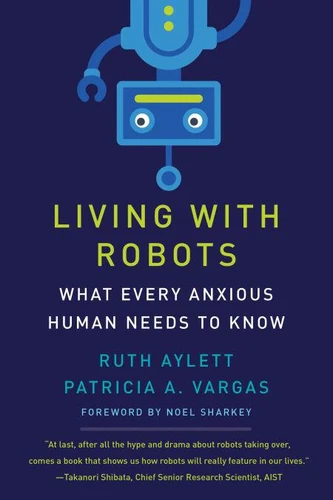Living with Robots. What Every Anxious Human Needs to Know
Par : , ,Formats :
Disponible dans votre compte client Decitre ou Furet du Nord dès validation de votre commande. Le format ePub protégé est :
- Compatible avec une lecture sur My Vivlio (smartphone, tablette, ordinateur)
- Compatible avec une lecture sur liseuses Vivlio
- Pour les liseuses autres que Vivlio, vous devez utiliser le logiciel Adobe Digital Edition. Non compatible avec la lecture sur les liseuses Kindle, Remarkable et Sony
- Non compatible avec un achat hors France métropolitaine
 , qui est-ce ?
, qui est-ce ?Notre partenaire de plateforme de lecture numérique où vous retrouverez l'ensemble de vos ebooks gratuitement
Pour en savoir plus sur nos ebooks, consultez notre aide en ligne ici
- Nombre de pages312
- FormatePub
- ISBN978-0-262-36547-5
- EAN9780262365475
- Date de parution21/09/2021
- Protection num.Adobe DRM
- Taille15 Mo
- Infos supplémentairesepub
- ÉditeurThe MIT Press
Résumé
THE TRUTH ABOUT ROBOTS: Two robotics experts look beyond the hype, offering a lively and accessible guide to what robots can (and can't) do. There's a lot of hype about robots; some of it is scary and some of it utopian. In this accessible book, two robotics experts reveal the truth about what robots can and can't do, how they work, and what we can reasonably expect their future capabilities to be.
It will not only make you think differently about the capabilities of robots; it will make you think differently about the capabilities of humans. Find out:. Why robots can swim and fly but find it difficult to walk . Which robot features are inspired by animals and insects. Why we develop feelings for robots . Which human abilities are hard for robots to emulateRuth Aylett and Patricia Vargas discuss the history of our fascination with robots-from chatbots and prosthetics to autonomous cars and robot swarms.
They show us the ways in which robots outperform humans and the ways they fall woefully short of our superior talents. They explain how robots see, feel, hear, think, and learn; describe how robots can cooperate; and consider robots as pets, butlers, and companions. Finally, they look at robots that raise ethical and social issues: killer robots, sexbots, and robots that might be gunning for your job.
Living with Robots equips readers to look at robots concretely-as human-made artifacts rather than placeholders for our anxieties.
It will not only make you think differently about the capabilities of robots; it will make you think differently about the capabilities of humans. Find out:. Why robots can swim and fly but find it difficult to walk . Which robot features are inspired by animals and insects. Why we develop feelings for robots . Which human abilities are hard for robots to emulateRuth Aylett and Patricia Vargas discuss the history of our fascination with robots-from chatbots and prosthetics to autonomous cars and robot swarms.
They show us the ways in which robots outperform humans and the ways they fall woefully short of our superior talents. They explain how robots see, feel, hear, think, and learn; describe how robots can cooperate; and consider robots as pets, butlers, and companions. Finally, they look at robots that raise ethical and social issues: killer robots, sexbots, and robots that might be gunning for your job.
Living with Robots equips readers to look at robots concretely-as human-made artifacts rather than placeholders for our anxieties.
THE TRUTH ABOUT ROBOTS: Two robotics experts look beyond the hype, offering a lively and accessible guide to what robots can (and can't) do. There's a lot of hype about robots; some of it is scary and some of it utopian. In this accessible book, two robotics experts reveal the truth about what robots can and can't do, how they work, and what we can reasonably expect their future capabilities to be.
It will not only make you think differently about the capabilities of robots; it will make you think differently about the capabilities of humans. Find out:. Why robots can swim and fly but find it difficult to walk . Which robot features are inspired by animals and insects. Why we develop feelings for robots . Which human abilities are hard for robots to emulateRuth Aylett and Patricia Vargas discuss the history of our fascination with robots-from chatbots and prosthetics to autonomous cars and robot swarms.
They show us the ways in which robots outperform humans and the ways they fall woefully short of our superior talents. They explain how robots see, feel, hear, think, and learn; describe how robots can cooperate; and consider robots as pets, butlers, and companions. Finally, they look at robots that raise ethical and social issues: killer robots, sexbots, and robots that might be gunning for your job.
Living with Robots equips readers to look at robots concretely-as human-made artifacts rather than placeholders for our anxieties.
It will not only make you think differently about the capabilities of robots; it will make you think differently about the capabilities of humans. Find out:. Why robots can swim and fly but find it difficult to walk . Which robot features are inspired by animals and insects. Why we develop feelings for robots . Which human abilities are hard for robots to emulateRuth Aylett and Patricia Vargas discuss the history of our fascination with robots-from chatbots and prosthetics to autonomous cars and robot swarms.
They show us the ways in which robots outperform humans and the ways they fall woefully short of our superior talents. They explain how robots see, feel, hear, think, and learn; describe how robots can cooperate; and consider robots as pets, butlers, and companions. Finally, they look at robots that raise ethical and social issues: killer robots, sexbots, and robots that might be gunning for your job.
Living with Robots equips readers to look at robots concretely-as human-made artifacts rather than placeholders for our anxieties.



